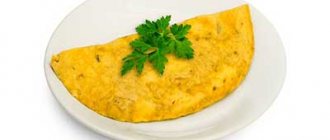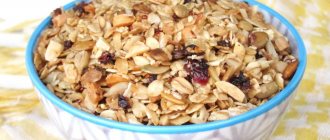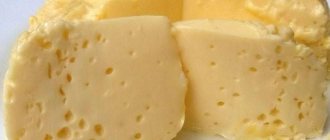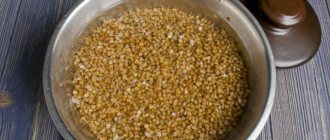Protein omelet is one of the main dishes in a healthy diet.
Omelette is popular among those who monitor their health and figure, as well as among people who are professionally involved in sports. This dish is universal - you can make an omelette with any fillings: herbs, vegetables, cheese, cottage cheese, bran or oatmeal and then you won’t get tired of this breakfast.
What are the benefits of egg white omelette?
Proteins are the “building material” for cells that the human body needs every day. But omelet has other beneficial properties that are worth discussing:
- If a person is trying to lose weight, then eating such a dish will help him get the substances necessary for the normal functioning of the body, avoiding the accumulation of extra calories.
- Protein is necessary for normal hair and nail growth, and it helps improve the quality of the skin.
- When a person engages in strength sports, proteins will help gain muscle mass.
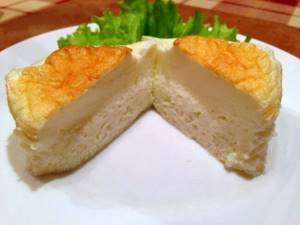
Protein omelet is also useful because it helps normalize metabolic processes. For this reason, it is recommended to eat it in the morning, preferably in the first half of the day.
Other benefits:
- does not contain cholesterol;
- does not contribute to the development of atherosclerotic changes in blood vessels;
- easy to digest, does not disrupt the functioning of the digestive system;
- helps satisfy hunger.
It is believed that an omelet saturates the body and promotes satiety, but this statement is only partly true. The dish is light and digests quickly, gives a surge of energy and strength, but this state is fleeting, provided that the body is subjected to serious physical stress.
As for the disadvantages, there are not so many of them in an omelet made from proteins; it is worth noting only individual intolerance. Allergies to eggs are not uncommon; if you have one, you should avoid eating foods that contain this product.
Composition of nutrients, BJU
The composition consists mainly of protein, there is not much fat and carbohydrates in it. Provided that the omelette was prepared according to the classic recipe.
| Nutritional value of an omelet made from egg whites: | The calorie content of the product per 100 grams is on average 46 kcal. | Protein contains at least 72 grams. | There is very little fat, about 1 gram. | As for carbohydrates, there are approximately 2.3 grams. |
Milk, as well as adding other ingredients to the dish, can increase the calorie content of the product.
How many calories are in an omelette without yolk?
An omelette with vegetables without yolks (100 g) contains:
- Proteins – 7.6 g;
- Fat – 8.2 g;
- Carbohydrates – 2.6 g;
- The calorie content of the product is 111 kcal.
For many people, such an omelet recipe loses its taste, but the choice is up to the consumer: either food with less calories, or the taste of the product. In an omelet with vegetables, the absence of yolks in the product will not be so noticeable, since each vegetable brings its own individual “notes” to the dish.
Protein omelet - general principles of preparation
There are several variations of preparing an omelet. But it’s worth starting with some background. This dish is “mysterious” and historians have never been able to establish who and when first prepared it.
According to one version, it is believed that the omelette was first served to the French monarch. And another tells that beggars learned to mix eggs and fry them.
Read: How to eat muesli correctly, recommendations for consumption

But regardless of historical events, an omelette prepared according to a French recipe is considered a “classic”. In this case, beat the eggs without removing the yolks, add milk or cream and fry on one side without stirring. Before serving, roll it up.
But there are other variations in preparing the dish:
- An omelette made from whites is made without yolks at all, or they can leave one, clearly placing it in the central part. In this case, only the whites are beaten.
- Omelette is prepared not only using milk, but also with water and cream.
- You can beat the whites, or you can just mix them lightly. This technology does not affect the taste characteristics.
The traditional recipe is one that contains 3 ingredients:
- milk;
- egg whites, pre-beaten with a whisk or fork;
- salt.
The omelette is fried in a hot frying pan, after pouring a little oil. The dish is prepared quickly; do not stir it during the process. Remove from heat when the bottom is browned.
But you can cook the dish in the oven; modern housewives often use a multicooker for this purpose.
Preferences of representatives of various countries:
- The British love to have an egg omelette with garlic for breakfast. The clove is fried separately, skewered on a fork and the combination is enjoyed.
- In Japan, egg omelette with noodles is incredibly popular.
- There are true gourmets living in Italy; they prefer a dish moderately seasoned with fresh herbs.
Popular omelet recipes
The most delicious, healthy and nutritious omelette can be easily prepared at home, reducing the standard calorie content by adding additional components to the preparation. How to do this is described in the recipes below.
Omelette with tomatoes
A very light and delicious-looking omelette is made with fresh tomatoes and onions. To prepare it, use the following ingredients:
- 2 chicken eggs;
- 100 g onions;
- 200 g tomatoes;
- 25 ml;
- 1 g table salt.
We clean and rinse, then cut it into half rings. After this, put the resulting mass in a heated frying pan and add oil. Fry over medium heat for about five minutes, stirring constantly. While the onion is frying, cut into thin slices.
Add them to the onion and fry the mixture for another minute or two. Meanwhile, beat the eggs a little with salt, then pour the resulting mixture over the cooking vegetables. Fry the omelette for about five more minutes. Calorie content per 100 g
omelette with tomatoes is
76 kcal.
Cheese omelette
Those who love dishes with cheese will certainly appreciate this type of omelet despite the increased calorie content. To prepare it without any problems, choose the following ingredients:
- 1 chicken egg;
- 3 egg whites;
- 25 ml milk;
- 3 ml sunflower oil;
- 50 g;
- 2 g table salt.
Heat the pan in a frying pan using medium heat. Meanwhile, beat the egg with milk, beat the whites separately with table salt. Combine the two resulting mixtures in one bowl, beat in a blender or using a whisk for about a minute.
Separately, grate the cheese on a medium grater. Pour the mixture into a frying pan, sprinkle with grated cheese and cook for about five minutes with the lid closed. Calorie content of omelet with cheese per 100 grams
is
130 kcal.
Omelette with sausage
Sausage is considered a high-calorie product, but few can resist preparing this much-loved dish for breakfast or midday lunch. The omelet turns out perfect if you take the following components:
- 100 g raw smoked sausage;
- 5 chicken eggs;
- 200 ml milk;
- 50 g onions;
- 20 ml sunflower oil;
- 2 g table salt.
In a preheated frying pan, heat the sunflower oil, at this time cut the onion and sausage into cubes. Separately, beat the milk and eggs using a blender, adding a pinch of salt. Pour the sausage and onions into the frying pan, stir with a spatula and fry for about five minutes, trying to prevent the ingredients from burning.
After this, pour the egg-milk mixture onto the sausage, cover the frying pan with a lid and cook the omelette over low heat for about seven minutes. Calorie content of omelette with sausage per 100 grams
is approximately
185 kcal
.
Zucchini omelette
A tender omelette with delicious zucchini is a dietary dish recommended for those trying to lose weight. Baking in the oven makes this dish as light and tasty as possible. Its preparation is impossible without the following components:
We cut the zucchini into thin rings, and try to cut the tomatoes, onions and carrots into half rings. Grease a baking tray or baking dish with oil, place carrots on it, then onions, zucchini and prepared tomato. Sprinkle the dough with salt on top and bake the mixture in the oven for about twenty minutes at a temperature of about 200 degrees.
Meanwhile, prepare the sauce: beat the eggs and whites with a blender, then add water and milk. Beat a little more and remove the vegetables from the oven. Pour them with the prepared sauce and sprinkle with chopped herbs.
Place grated or finely shredded cheese on top and put the pan back in the oven. We keep the product there for approximately ten minutes. Calorie content of omelet with zucchini per 100 g
stays within
75 kcal.
Try to use greens more often
while preparing different types of omelettes. It will not only improve the taste of any dish, but will also greatly contribute to the rapid absorption of food.
It's hard to imagine a dish more suitable for breakfast than an omelette. Hearty, nutritious and incredibly tasty, it is prepared in a matter of minutes and is loved by both adults and children. Even a small portion of this delicious and at the same time very simple dish will give you energy and vigor and relieve hunger for a long time.
In addition, the pliable egg base allows you to include a variety of ingredients in the recipe: vegetables, herbs, meat and meat products, fish and seafood, mushrooms and even legumes! That is why an omelet can change its calorie content depending on its composition.
The beneficial properties of the dish, as well as the possible harm from it, are largely due to the main ingredient - eggs. And the egg, as you know, is a storehouse of useful substances, because it contains everything necessary for the normal development and growth of the chick.
Vitamins A, C, D, E, group B, as well as selenium, potassium, calcium, iron - the full list will be very, very long. Regular consumption of egg omelets will help strengthen the nervous system, improve the condition of bones, teeth and nails, improve the functioning of the cardiovascular system, form beautiful and strong muscles, increase hemoglobin levels, maintain excellent vision and protect the brain from age-related changes.
And yet, doctors strongly advise strictly dosing eggs in the diet. This is primarily due to the fact that the product often causes allergies, especially in young children and people with egg white intolerance.
In addition, the yolk contains a lot of cholesterol, which, together with cholesterol from animal fats - lard or butter - forms plaques in the blood vessels.
100 grams of omelette contains 9.6 grams of protein, 15.4 grams of fat and only 1.9 grams of carbohydrates.
Protein omelet “Dietary” with herbs
This dish is suitable for those who are watching their figure and trying to provide the body with the necessary microelements and nutrients.
| Ingredients: | 4 egg whites; salt and spices to taste; 2 tablespoons milk; 1 teaspoon of oil, preferably olive, but sunflower will do; 100 grams greens from the garden. |
| How to cook: | It is worth whipping the egg whites, cutting the herbs and mixing the ingredients; when foam appears, add salt and pepper. Heat the frying pan and, without stopping whisking, pour the contents into the frying pan. Cook the dish for 2 minutes, then turn it over and wait exactly one minute. Garnish with chopped tomatoes and serve. |
How many calories are in an omelet without butter?
Calorie content of 100 grams of various oils with which most people prepare omelettes:
- Olive – 198 kcal;
- Sunflower – 578 kcal;
- Creamy – 748 kcal;
- Peanut and corn - 899 kcal each.
We remove 20 - 30 grams of oil from the recipe, and we get a significant saving in kilocalories consumed. Of course, you won’t be able to fry an omelette in a frying pan on a gas stove without any oil, but preparing a delicious product in the oven or slow cooker is easy and simple. You can also cook an omelet without oil in the microwave, but...
In our opinion, an omelette in the oven gives a special taste, because the product is cooked not only from below, as on a gas stove, but also from above. We are sure that most “second” dishes baked in the oven or multicooker are much tastier than those cooked on a gas stove.
In our opinion, an omelet in a microwave does not have that “flavorful zest” that makes a man say to a woman: “Thank you, dear, the omelet was delicious.” The microwave was invented not for gourmets, but for people who are constantly in a hurry to get somewhere.
Protein omelet with cottage cheese and green onions
It has one cooking feature: whites are used, but 1 yolk is left, this will help:
- improve the taste of the dish;
- reduce its calorie content;
- obtain the necessary substances.
The fat content of the product will be minimal, even if only 1 yolk remains. It is recommended to prepare the dish according to the following recipe:
- Beat the whites and one yolk together.
- Then add cottage cheese, preference is given to low-fat cottage cheese.
- We cut the greens and add them to the curd-egg mixture.
- A little salt and pepper will make the dish tastier.

Heat a frying pan, pour a little oil, pour the prepared mixture onto it. The omelette will be ready in a few minutes when it acquires a dense consistency. It is served warm to the table.
Is the recipe classic or innovative?
The national cuisine of different countries can boast of its own version of the omelet. In Italy, for example, this dish is called frittata, in Spain – tortilla, in Japan – omu-rice and omu-soba. Preparation technologies, as well as the composition, vary greatly. The omelet is fried, baked, steamed.
It is simmered with vegetables, most often with tomatoes, fresh herbs, boiled or fried meat, fish or seafood fillets, slices of bread, all kinds of cheese, boiled or fried mushrooms are added to it, and in a sweet, with sugar or honey, omelette - yes -Yes, it happens! – pieces of fresh or dried fruits and candied fruits are good. The inventive Japanese even developed a recipe for omelette with rice!
However, the classic recipe for the dish does not require any special frills. Beaten eggs, milk and a pinch of salt - that's all. The ingredients are thoroughly mixed and fried in a well-heated thick-walled frying pan with a flat bottom.
You will get a fluffy, almost airy omelette if you beat the whites and yolks separately, combine them with milk in a large blender bowl and keep it on for another minute.
Protein omelet with cheese
An interesting breakfast option, I offer a simple method that will allow you to create a delicious dish in a few minutes:
- It’s worth whipping a few whites and 1 yolk;
- first grate the hard cheese on a coarse grater;
- fry tomatoes and onions in a frying pan, chop the greens;
- add greens to the whites with the yolk, pour everything into the frying pan where the tomatoes and onions are located;
- Bring the dish to half-cooking, sprinkle with grated cheese, and cover with a lid.
After a few minutes, turn off the heat, but do not remove the lid. Let the omelet sit for a while, at least 3 minutes. Serve, sprinkle with grated cheese again before serving.

But there is another option for preparing the dish, which uses cottage cheese. In this case, you will have to follow the following recommendations:
- Cut the curd cheese into cubes and mash it with a fork.
- Add pre-whipped whites to the mixture.
- Chop the greens: onion, dill, parsley, basil, add to the total mass.
- Heat a frying pan, pour a little olive oil, pour in the omelette.
- Cook for 3 minutes on one side, turn over and wait another 1.5 minutes.
- Cover everything with a lid and let it sit for a while.
- At this time, cut the tomato and curd cheese.
- Place the dish on a plate, garnish with tomato and cheese, and serve, not forgetting to add salt and pepper.
The second option for preparing an omelet will help give a well-known dish bright flavor characteristics.
Classic omelet recipe
Many of us remember the thick and completely unappetizing omelettes of Soviet canteens, but today there is no need to cook them exactly like that - your skillful hands will help you make the perfect classic omelet. To make your omelette truly delicious, choose the following ingredients:
- 1 chicken egg;
- 25 ml milk;
- 3 g table salt;
- 2 g ground black pepper;
- 3 ml sunflower oil.
Place the pan on medium heat and add it to it. stir a little in a deep bowl, then add to it. Beat the mixture with a whisk or in a blender until completely smooth, add pepper and table salt. Stir the mixture again and pour it into the heated frying pan.
Fry the workpiece on one side for about 2 minutes, then turn over with a spatula. Cover the pan with a lid and fry the omelette until cooked, the process will take another two minutes. Calorie content of omelet with milk from 1 egg
per
100 g
is
106 kcal
,
from 3 eggs – 125.1 kcal.
Protein omelet with cauliflower and cheese
I suggest preparing a dish with feta cheese and fresh herbs; the taste will be interesting and rich.
| What you will need: | cauliflower, several inflorescences; grated cheese; several egg whites; salt, pepper, herbs, milk. |
| Action diagram: | We wash and dry the inflorescences, then boil them in boiling water, cook for 3 minutes from the moment of boiling. Mix the whites with milk, no need to beat, you can leave one yolk. Place the cauliflower in a container, fill it with the mixture, sprinkle with herbs, sprinkle everything with cheese and put it in the oven. The temperature in it should be 175 degrees. You should not beat the whites, because during the cooking process the omelette will “rise” on its own. But if you beat them into foam, the dish will settle a lot and will not look very attractive in appearance. |
You can bake the omelette in silicone molds designed for muffins and serve it to guests in portions as a snack.
Ways to reduce the calorie content of an omelet
- We prepare the product using household appliances. An omelet in a slow cooker or double boiler has slightly fewer calories. Naturally, such an omelette will not have the delicious crust that many people love;
- We reduce the number of eggs in the omelet to a reasonable limit and add various vegetables, herbs, do not use mayonnaise and ketchup;
- We prepare the omelette without yolks, using high-quality water (melt). Any lazy person who has a refrigerator with a freezer can prepare melt water;
- We prepare an omelette without using any oil (even the “favorite” of all nutritionists, olive oil).
Protein omelet with chicken fillet in a slow cooker
A tasty and nutritious dish that takes no longer than 25 minutes to prepare. What do we have to do:
- rinse and then cut the fillet into cubes;
- tomatoes and onions - in half rings;
- Mix the whites with milk, turn on the multicooker;
- select the “baking” mode, set the timer for 30 minutes;
- after 5 minutes, pour a little oil into the bowl, add the fillet and vegetables, cook for another 5 minutes;
- then fill the components with proteins mixed with milk, salt and pepper;
- the dish will be ready in 20 minutes, it can be decorated with fresh herbs and served.
Read: How to eat muesli correctly, recommendations for consumption
With ham or sausage
It’s a tasty dish, but it’s a stretch to call it healthy for several reasons: it’s cooked in a frying pan, which means it contains carcinogens; fried sausage hardly fits the definition of “healthy food.”
| Components: | 4 egg whites; 150 grams of sausage or ham; a little butter; greens to taste; milk 2 tablespoons. |
| Cooking method: | Mode Dice the ham or sausage and fry it in a frying pan until half cooked, you can add onion or garlic, but it all depends on preference. Beat the whites together with milk, add salt and pepper, and throw in a piece of butter. Pour into a frying pan. Fry on one side for 3 minutes, then cover the dish with a lid, after 3 minutes it will be ready. |
Calorie comparison table for all recipes
Let's study the calorie content of all the recipes described above, this will help you understand which cooking method should be preferred in a given situation:
| Traditional recipe: | Averages 80 calories per serving. |
| Dietary with greens: | No more than 90 kcal. |
| With cottage cheese and green onions: | Averages 260 calories per serving. |
| With vegetables: | No more than 160 calories per serving |
| With cheese: | Does not exceed 50 kcal per 100 grams. |
| With cauliflower and cheese: | Approximately 60 calories. |
| With chicken fillet in a slow cooker: | No more than 110 calories. |
| With sausage or ham: | On average, the figure does not exceed 300 kcal per serving. |
Much depends on the components that complement the dish; there are not many calories in vegetables, but there are much more in sausage. But even if we sat down to prepare an omelette according to this recipe, it can still be called a low-calorie dish.
There are many recipes in cooking that will help you create a delicious dish without much effort. The popularity of the omelet decreased when doctors and nutritionists started talking about the fact that egg yolks can cause atherosclerosis. But you can find a way out of any situation. An alternative was a protein omelet with vegetables, cottage cheese, herbs and ham. This is a tasty and healthy dish, rich in proteins and improves the functioning of the digestive system.
Recommended video:
Having found out how many calories are contained in a protein omelet, many housewives will probably want to cook and eat it. Considering that creating a dish does not require deep knowledge of cooking. In addition, this is a kind of “platform” for experiments, which will help turn cooking into “creativity”.
Read along with this article:
- Eating right: calorie content of omelet
- Is it possible for a nursing mother to boil a boiled egg - the benefits of the product and possible harm
- Diet for muscle growth or proper nutrition for gaining muscle mass
- We count the calorie content of omelettes and other “light” dishes
- Coconut milk calorie content, composition, properties
- How much protein is in shrimp, what is the calorie content of the product and its...
- How many calories are in a soft-boiled egg and its benefits for weight loss
- Foods containing large amounts of protein: benefits for the body
- What are the benefits of spinach for women, how to use its properties
How many calories are in an omelet without butter?
Calorie content of 100 grams of various oils with which most people prepare omelettes:
- Olive – 198 kcal;
- Sunflower – 578 kcal;
- Creamy – 748 kcal;
- Peanut and corn - 899 kcal each.
We remove 20 - 30 grams of oil from the recipe, and we get a significant saving in kilocalories consumed. Of course, you won’t be able to fry an omelette in a frying pan on a gas stove without any oil, but preparing a delicious product in the oven or slow cooker is easy and simple. You can also cook an omelet without oil in the microwave, but...
6. Omelette of 2 eggs with milk and tomatoes
The calorie content of a simple omelet made from two eggs and milk, cooked with a minimum amount of butter, is 161 kcal.
The most popular variation of this dish involves adding tomatoes.
An omelette made with milk with two eggs and the addition of a tomato contains 151 kcal per 100 grams.
To reduce the energy value of the dish, you can use skim milk or use a few more techniques.
7. How many calories are in an omelet made from 1 egg and milk?
The calorie content of this recipe depends on the method of preparing the dish: in the oven, in a slow cooker, fry in a frying pan on a gas stove.
Preparing an omelet by frying on the stove is the most high-calorie and “dangerous” option for the body: during frying, carcinogenic substances are formed to a greater or lesser extent in various fats, which negatively affect metabolic processes in the body.
On average, an omelet with milk and one egg contains 128.5 calories per 100 grams.
What are the benefits of an omelet?
When consumed in moderation, the benefits of omelet are quite large:
- the dish is rich in vitamins and minerals that strengthen the immune system;
- omelet is indicated for chronic muscle pain and headaches;
- the B vitamins contained in the omelet are beneficial for the health of the nervous system;
- the main component of the omelet is chicken eggs, which contain a lot of vitamins A, E, D;
- omelette vitamin A is a natural antioxidant that is beneficial for the health of bones, eyes, skin, as well as the regulation of protein synthesis during oxidative and reduction processes;
- omelet B vitamins are useful for maintaining muscle tone and accelerating metabolism;
- vitamin E in the product is necessary to increase the elasticity of blood vessels and rapid healing of wounds;
- Calcium and carbonate from egg dishes are used to stimulate bone marrow function.
Harmful effects of omelet The following harmful properties of omelet are known: the cholesterol contained in the dish clogs blood vessels; an overcooked omelette loses up to 95% of its nutrients; an omelet made from low-quality eggs can cause salmonellosis; Many people develop allergic reactions to the components in the dish, including possible intolerance to egg whites and butter.
How to cook a delicious omelet
To prepare the dish you will need:
- 3 chicken eggs,
- 35 g butter,
- a quarter teaspoon of salt,
- a fifth of a teaspoon of ground pepper.
Cooking steps:
- Beat the eggs with a fork until the mixture becomes homogeneous.
- Be careful not to over-beat the eggs, which can cause the omelet to be too dense.
- Place 35 g of butter on a well-heated frying pan over medium heat.
- As soon as the butter melts, pour the previously obtained egg mixture onto it.
- Frying the omelet lasts 1.5 - 2 minutes.
- The indicator of readiness of the dish is a golden crust on the sides, slightly viscous in the middle. Remove the finished omelette from the heat, sprinkle with ground pepper and salt. The dish goes well with rye bread and vegetables. Bon appetit!
The calorie content of an omelet per 100 grams is 184 kcal. 100 g of product contains: 9.6 g of proteins; 15.4 g fat; 1.9 g carbohydrates. The vitamin and mineral composition of the omelet is represented by vitamins A, B2, B9, B12, E, D, calcium, potassium, lecithin, iron, lutein, selenium.
The average calorie content of 100 grams of omelet is 185 kcal.
It contains:
- carbohydrates 2 g;
- proteins 11 g;
- fat 15 gr.
An omelet can be made from different quantities of eggs and milk of any fat content, so when calculating the individual energy value you need to know the base load:
In 100 gr. eggs contain 157 kcal, and the same amount of milk with a fat content of 3.2% is 59 kcal.
Based on this, you can determine the calorie content of the dish you prepare at home.
Result:
100 grams of various omelet recipes contain (kcal):
- With one egg with milk – 128.5;
- With two eggs and milk – 178;
- In an omelet with milk and three eggs – 216;
- To the recipe for an omelet with tomatoes you need to “add” the calorie content of the vegetable - 30 kcal;
- In an omelette without yolks – 111;-
- In an omelet with water, we “minus” the energy value of milk - 64 kcal per 100 g.
- In an omelet with broccoli, the energy value is higher by the calorie content of “overseas” cabbage - 28 per 100 g.

